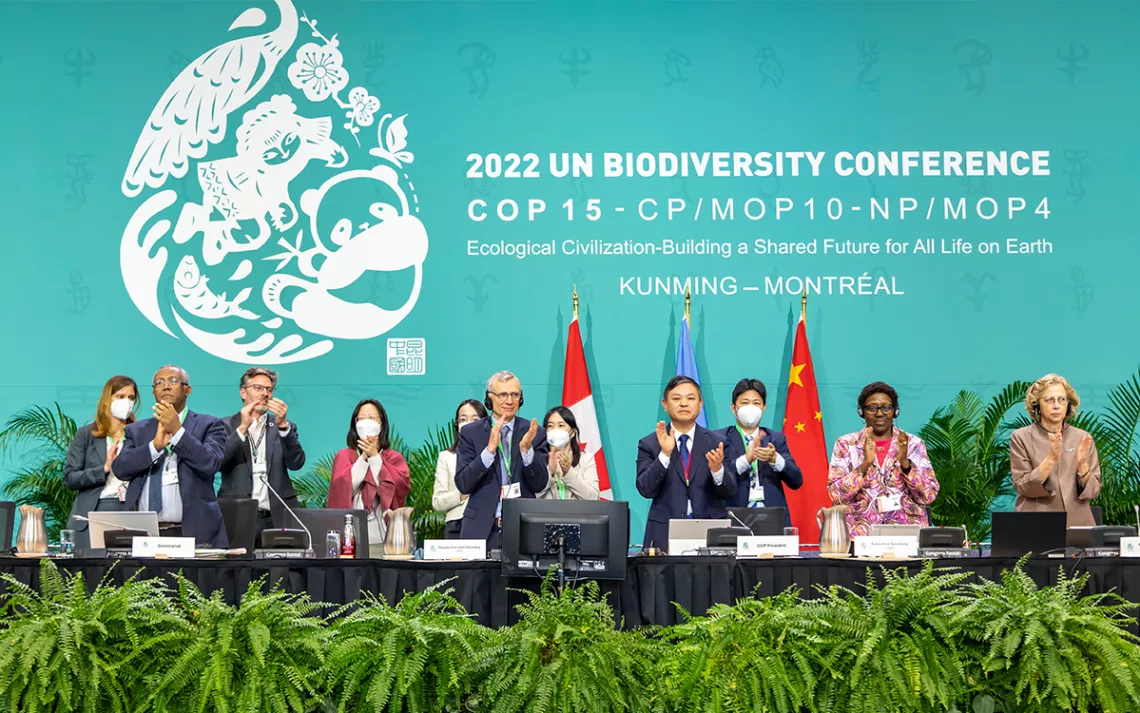Deal Reached to Save Wildlife and Nature
COP15 biodiversity conference ends in Montreal with lots of ambition

Adoption of the Kunming-Montreal Global Biodiversity Framework. | Photo by Julian Haber/UN
On December 19, over 190 United Nations countries agreed to a framework to safeguard wildlife and live in greater harmony with nature—the last day of a biodiversity conference during which such a deal could be reached. The meeting, which was postponed in 2020, has been several years in the making and included hundreds of hours of negotiations over two weeks with many compromises among the parties.
The outcome, known as the Kunming-Montreal Agreement, represents one of the most significant steps toward halting and then reversing the loss of wildlife by 2030. The delegates created this singular goal as the guiding principle for the new deal. Experts say that doing this offers the best chance for the world to reach the three objectives outlined in the Global Biodiversity Framework: to conserve wildlife, ensure sustainable use of nature, and equitably share genetic resources.
“The last two weeks in Montreal placed nature at the forefront of global policy discussions. The agreement struck today among the participating 196 countries could mark a turning point in mending our broken relationship with nature,” said Carter Roberts, president and CEO of the World Wildlife Fund-US, in a statement. “In the US, we take heart that—though our country is not a party to the underlying convention—the Biden administration has already embraced many of the principles of the agreement.”
Today, wildlife species are most threatened by habitat loss due to agriculture, exploitation due to overhunting, climate change, invasive species, and pollution. The new framework includes four overall goals and 23 targets that touch on each of these drivers of wildlife decline and offers much-needed solutions to help reverse biodiversity loss.
Among some of the targets that were agreed to include a pledge to protect and conserve 30 percent of Earth’s land, freshwater, and oceans by 2030, a critical goal that at least 120 nations had already committed to, including the United States, which is not a member of the convention. Additionally, the countries vowed to respect the rights and input of Indigenous communities, eliminate subsidies that are harmful to nature, and to gradually increase the amount of finance for nature conservation to $200 billion by 2030. A part of that funding will come from the Global Environment Facility, a multilateral, United Nations-style funding mechanism for conservation projects.
Along with the Global Biodiversity Framework, five other frameworks were passed by the governing panel: monitoring, capacity building, planning and review, financing, and digital sequencing information. The last category requires countries to share genetic information obtained from nature equitably. This information, which includes DNA, is key to providing scientific breakthroughs in areas such as medicine, agriculture, and combating poaching and wildlife smuggling.
While there were some initial concerns, the delegates broke out into a round of applause following the gavel drop by Huang Runqiu, the president of the Fifteenth Meeting of the Conference of the Parties (COP15). “After four years of work, we have now reached the end of our journey,” said Runqiu, who is also the Chinese Environment Minister, to the crowd of delegates around 4 a.m. local time. “And we have before us the fruits of our work … which I think can guide us all to work together to halt and reverse biodiversity loss, to put biodiversity on the path of recovery.”
There was some discord after a group of African nations expressed a desire for more clarity and assurance that funding from developed countries would flow to developing countries. Many of them, including some of the most biodiversity-rich nations on the planet, said this is needed to help meet the conservation targets. “Under Article 20 of the convention, the parties which are developed nations should provide resources to countries which are developing so as to support the additional costs of implementation,” said one delegate from the Democratic Republic of Congo. “Our experience demonstrates that we are not yet ready with this process.” Another, from Cameroon, said the deal was passed by “forced hand.”
Despite these grievances, none of the delegates raised formal objections to the passage of the package, said David Ainsworth, from the Information Office at the United Nations Environment Programme. In effect, the agreement passed unanimously. In addition to some funding concerns, NGOs like the Center for Biological Diversity said the agreement didn’t go far enough in committing to immediately ending human-caused extinctions. And Lina Barrera, the vice president for International Policy Conservation International, said that some of the ambition was weakened in targets meant to address climate change and foster nature’s contributions to people.
Overall, though, many groups feel the agreement is a win for wildlife and nature. Additional targets agreed to include restoring at least 30 percent of degraded lands, reducing the loss of biodiversity-rich areas to near zero, cutting global food waste in half, reducing the number of introduced invasive species, and requiring large transnational companies to disclose the risk their activities pose to nature.
Next comes the more arduous task of actually implementing the plans. The lack of political will to put in place the previous biodiversity framework, called the Aichi Targets, was primarily seen as its biggest failure. More than a decade after that agreement was reached, none of those targets have been reached. According to people close to this year’s negotiations, a dedicated monitoring and review process will hopefully help bolster countries' efforts to put together the biodiversity strategies and plans needed to reach the targets.
The condensed time frame that counties have to achieve the goals makes the job even more complicated. The GBF is meant to be a decade agreement, but since the first COP15 was postponed until now, countries only have eight years to achieve what was supposed to be done in 10. While the collection of frameworks has been agreed to, there’s still plenty of work to be done. Working groups, where representatives for delegates convene to discuss ideas within the agreement, have yet to meet to discuss the long-term goals and strategy for mainstreaming wildlife considerations into society.
There’s also more work to be done on how to bridge the financing gap of $700 billion needed to tackle all of the threats that nature is currently under. Over the next eight years, countries need to turn these targets into action, which many hope will start before COP16 in Turkey in 2024.
“There is a lot of good here,” Barrera told Sierra. “If we really implement it thoughtfully and with ambition, we will have a different reality. It'll be the kind of transformation we need.”
 The Magazine of The Sierra Club
The Magazine of The Sierra Club







